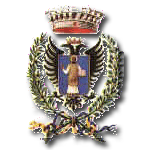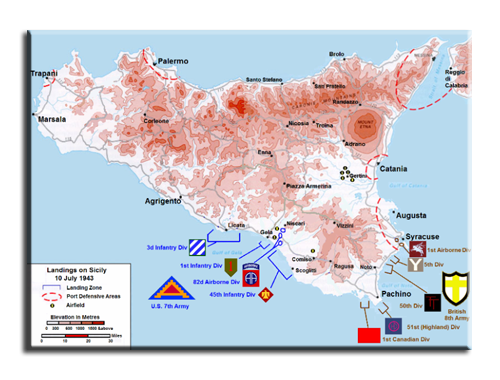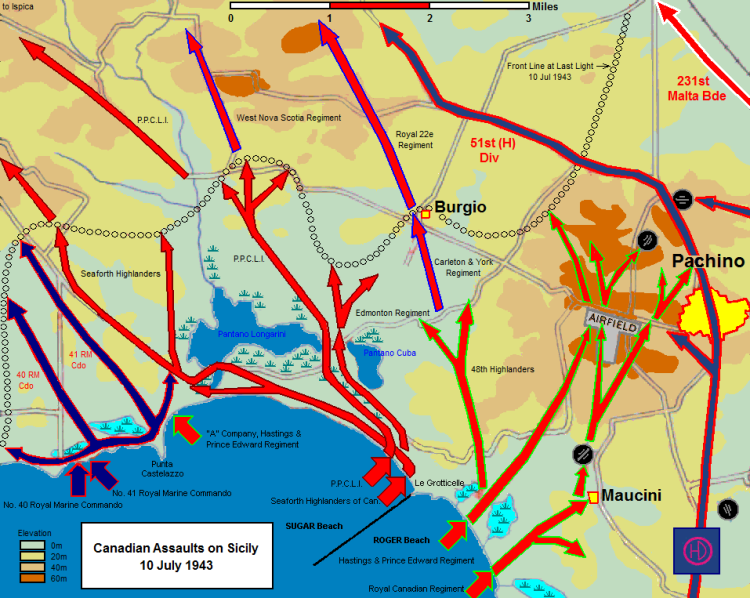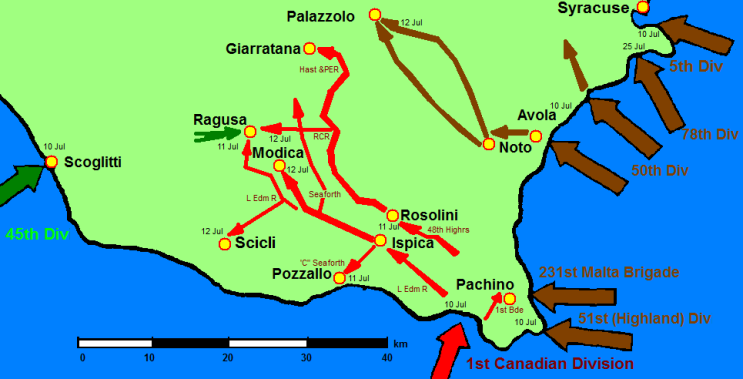
 Translate
Translate
-
* News
- - Agira 2018, 75 years later
- - Agira 2013, 70 years later
- - Gallery of ceremony 2013
- - Operation Husky 2013
- * Students' Contribute
- * About Us
- * Visitor's Book
- * Collaborators
- * Canadian Battles
- * Italian Defensive Positions
- * Allied Forces
- * Historical Movies
- Historical Information
- Historical Maps
- * Bibliography
- Biographies
- * Catania War Cemetery
- * Moro River War Cemetery
- * Syracuse War Cemetery




Landing in Sicily was a Battle Honour granted to Canadian regiments that participated in the assault landings on the island of Sicily during the Second World War. The battle honour officially recognizes actions fought from 9 to 12 July 1943.
 The background to the assault landings in general are given in the article on Operation HUSKY. That code name was applied to the plan for the invasion of Sicily, which was finalized early in May 1943 and remained for the most part unchanged by D-Day, set for July 10. A significant feature that would change on D-Day was the name of the formations landing; Force 343 became the U.S. 7th Army and the British 12th Army, temporarily designated during the planning phase, reverted back to its historic designation of 8th Army.
The background to the assault landings in general are given in the article on Operation HUSKY. That code name was applied to the plan for the invasion of Sicily, which was finalized early in May 1943 and remained for the most part unchanged by D-Day, set for July 10. A significant feature that would change on D-Day was the name of the formations landing; Force 343 became the U.S. 7th Army and the British 12th Army, temporarily designated during the planning phase, reverted back to its historic designation of 8th Army.
The 2d U.S. Corps was to land the 1st and 45th Divisions in the Gulf of Gela, with the 3rd Division and 2d Armored
to land further west and seize Licata and both the port and airfield there. Paratroops of the 82d Airborne Division were to land four miles
from Gela to assist the 1st Division. The 8th Army's ambitious plan was to make five simultaneous landings on two coasts; on the right, the 13th
Corps was to land the 5th and 50th Divisions, preceded by the 1st Airborne's gliders and amphibious landings by commando troops. Their
goals were Syracuse and Catania.
On the left, 30th Corps was to land the 1st Canadian Division and the 51st (Highland) Division along with the independent 231st (Malta) Brigade astride the Pachino peninsula. The Highland Division was to land at BARK SOUTH beach and occupy Pachino itself, with BARK EAST designated for the Malta Brigade and the Canadians, driving for Pachino airfield, landing at BARK WEST, with a Special Service Brigade under command, comprised of No. 40 and No. 41 Royal Marine Commandos. It was expected the 8th Army would meet the U.S. 45th Division in the vicinity of Ragusa.
-
Force "H" - four battleships, four cruisers, two aircraft carriers, and eighteen destroyers - concentrated in the Ionian Sea as a deception plan, feigning an invasion of western Greece.
-
Force "Z" - in reserve in the western Mediterranean, to reinforce "H" or replace casualties at Sicily, as necessary.
-
Western Task Force - mainly U.S. Navy forces, divided into a Control Force and three Task Forces that corresponded to the three American beach landings.
-
Eastern Task Force - mainly Royal Navy forces, divided into Force "A" (13th Corps/231st Brigade) arriving from the Middle East), Force "B" (51st Division, arriving from Tunisia) and Force "V" (1st Canadian Division, arriving from the U.K.) Force "K" consisted of four cruisers and six destroyers tasked with close gun support for the landings.
Air Support
RAF fighter support from Malta and US fighter support from Tunisia was expected to operate with little opposition; enemy garrisons on Pantelleria and Lampedusa - small island garrisons lying between Allied-held Africa and the invasion beaches - were reduced by Allied bombing and assured the element of surprise to the naval forces. Pantelleria became home to Allied fighter squadrons, just 100 miles from the invasion beaches. In all, over 4300 aircraft from 250 Allied squadrons were available to operate against a much smaller Axis force.
1st Canadian Division
Terrain
The Amber Coast (Costa dell' Ambra in Italian) extends from a point two miles west of the extreme end of the Pachino peninsula, running five miles to the north-west in an arc, bounded by two headlands, the Cape of Ants (Punta delle Formiche) in the south and Castle Point (Punta Castellazzo) in the north. The long beach is divided in two naturally by "the Caves" (le Grotticelle), a small outcropping of limestone. It was this stretch of sand that became BARK WEST, the left half code named SUGAR and the right ROGER.
The beach itself offered no real obstacle; behind lay a limestone ridge with a maximum rise of 10 feet, with gently sloping ground behind covered in sand and patches of poor soil. Behind SUGAR lay marshy terrain, including the Pantano Longarini, a large slough impassable to motor vehicles. Farmer's fields were bounded by "dry stone" walls, and a rough cart track connected the provincial road running Pachino-Ispica to a point a mile inland from Grotticelle. Pachino's airfield sat at the junction of these roads - the only such airstrip on the peninsula - and the town lay a mile further east, home to 22,000 people, some three miles beyond ROGER.
The real obstacles lay to sea, where false beaches were discovered offshore, meaning infantry disembarking from landing craft might find themselves marooned on sandbars, on the wrong side of lagoons too deep to wade through to get to the island itself. One such sand bar was found off ROGER by a submarine patrol, over 600 yards long, 18 inches under the water, and with a nine-foot drop-off on the landward side. A shallower sandbar at SUGAR still had a five-foot drop. To meet this contingency, the Canadians put three assault companies into LCT landing craft carrying DUKW amphibious trucks.
Enemy Defences
Italian defenders from the 206th Coastal Division had an array of pillboxes, machine guns and two batteries of 6-inch guns. The Canadian official history described the defences all along the coast as "not very formidable." In the BARK WEST sector, there were fifteen pillboxes and about 20 machine gun posts, "some barbed wire" on the beach, and suspected anti-tank mines. Other defended positions lay inland, particularly towards the airfield. The two coastal batteries lay 1-1/2 miles north-east of ROGER, and two miles east, the latter in the sector of the 51st Division. A third battery (found to include four 6-inch howitzers) was sited on Pachino's northern outskirts, able to cover the approach to the airfield. Manned by determined troops, all of these defences would have been troublesome; as it was, the Canadians counted on enemy inexperience as well as aerial superiority and naval gunfire to help win the day.1
Canadian Plan
The plan called for the 1st Brigade to land on ROGER east of le Grotticelle, destroy the enemy battery at Maucini, capture the airfield at Pachino, and make contact with the British 30th Corps. The 2nd Brigade was to land to the west of le Groticelle on SUGAR, destroy beach defences, assist the Special Service Brigade and occupy positions north of the Pantano Longarini marsh from which it could patrol to the northwest. The Commandos of the Special Service Brigade, landing west of Punta Castellazzo, were given the responsibility of securing the extreme west flank of the 8th Army's assault zone; their landing was to precede H-Hour by ten minutes. The two infantry brigades were scheduled to land at H-Hour, set for 0245.
The monitor HMS Roberts provided gunfire support with its 15-inch guns, assisted by the cruiser Delhi and three destroyers. Each brigade also had a destroyer and four smaller craft for close escort to shore; the run-in was to be silent unless the enemy opened fire, to preserve surprise.
The 3rd Brigade, 12th Army Tank Regiment (Three Rivers Regiment), and various artillery and medical units, held as divisional reserve, were to be landed while the assault brigades advanced on high ground astride the Pachino-Ispica road. The third phase of the assault landing was to be an advance to the north-west alongside the 51st (Highland) Division.2
In the words of one historian, '(w)hile the Second Brigade, on the left, encountered only minor difficulties, the First Brigade's assault came dangerously close to complete collapse."3
2nd Brigade Landing
The Seaforths and PPCLI were transported to shore in LCA (Landing Craft, Assault), which were small, flat bottomed assault craft capable of carrying a single infantry platoon. . The PPCLI found little small arms fire greeted them; the Seaforth Highlanders found themselves put ashore too far to the right - in fact, on the wrong side of the Patricias.4
The day was a relatively easy one for the Seaforths;
The (Carrier Platoon), led by Major Forin, turned westward following the water-line to avoid mines. En route he ran into some of the Seaforth Platoons from "B" Company which were perplexed as to their location but he directed them to the right area. By about noon the carriers had met up with the remainder of the unit which was busy consolidating on the intermediate objective overlooking the beaches northwest of the inland lake.
The addition of the carriers, together with "B" Company's arrival, brought the Seaforths up to strength except for the administrative echelons which were due to arrive later. At some points on the high ground the men could see Ipsica, a town nestled on a rocky ridge about seven miles to the northwest where the first real resistance was expected after landing. So far the enemy had been flushed out without too much trouble, and the Italian prisoners were a sorry looking lot as they were despatched to compounds set up on the beach area now teeming with men, vehicles and supplies.5
The "silent" run in was abandoned as HMS Roberts bombarded Pachino airfield with its 15-inch guns, an experience the infantrymen in the landing craft reported as reassuring. Both units of the brigade reported only scatted small arms fire on the run-in to shore, which ceased as the troops reached land. According to the official history:
Once ashore, they easily cut through or blew up the few wire obstacles in their path, quickly disposing of a few machine-gun posts manned by a handful of bewildered Italian soldiers. At about three o'clock the headquarters and the remaining companies of each battalion followed the assault companies ashore. An hour later Brigadier Vokes, who was still afloat with his headquarters, had received success signals from both his assaulting units. Thereafter the two battalions proceeded inland towards their first phase objectives.6
The Special Service Brigade to their left landed farther west than planned, but the defenders in their sector evacuated their positions as soon as they faced danger, and the Commandos were quickly inland, making contact with the Seaforths in the vicinity of the southwest corner of the Pantano Longarini at 0640, having suffered light casualties. On the extreme left flank came the only serious resistance of the day, when late in the afternoon an Italian Blackshirt unit stopped the Commandos' advance with anti-tank and mortar fire, then threatened to penetrate the junction between the Seaforths and the Special Service Brigade. The 4.2-inch mortars of the Saskatoon Light Infantry were brought to bear to support the Commandos, who had no heavy weapons of their own, and 160 accurate rounds forced a withdrawal of the Italians, who abandoned their guns, horses and large amounts of ammunition.
1st Brigade Landing
The 1st Brigade was delayed in its attack because of the switch from LCAs to LCTs/DUKWs due to the discovery of the false beach. The LCTs were only due to arrive at 1215 on the day of the invasion; as a contingency the attack was to go ahead in LCAs as originally planned if the three LCTs (carrying 21 DUKWs) failed to arrive from Malta as scheduled. Due to radio silence, the brigade commander was thus forced to be prepared to go ahead with two different landing plans on short notice. The LCTs were also required to find the troopships in the dark, in rough weather, and in the event arrived late, the first not reaching its rendezvous until 0140, when the brigade had already begun embarking into the LCAs. A reorganization was ordered, and the first flight of Hastings and Prince Edward Regiment soldiers was ready to lower at 0226, by which time the first RCR companies were loading into LCTs as well. Loading was further delayed by the rough seas. Divisional HQ and the naval commanders sent word of their impatience; at 0315 the message "Will your assault ever start?" was sent to the Senior Naval Officer Landing on HMS Glengyle by Rear-Admiral Vian, commanding Force "V".
By this time, the two lead companies of the Hastings were ready to head for shore, in LCAs. The first flight of RCR did not depart until 0400, two and a half hours late. The Maucini battery fired on the craft, but was silenced by return fire from the Allied fleet. Both regiments landed in good order, though "A" Company of the Hastings, one of the reserve companies, landed 5,000 yards too far to the west, coming down in the Special Service Brigade's sector. The regiment suffered only two killed and three wounded during the landing, one of the dead being Company Sergeant Major Charles Nutley, killed by machine gun fire at the water's edge as he came ashore with "A" Company. No serious opposition was reported anywhere on ROGER Beach, and most Italians had fled by the time the Hastings landed proper at 0445 and the RCR at 0530. The 1st Division reported to 30th Corps at 0645 that it was on its first objectives.
The RCR cleared the buildings at Maucini where a dozen prisoners were taken, and the entire garrison of the battery (three officers and 35 men) succumbed after a single warning shot was fired by an RCR sergeant. They reached the airfield at Pachino by 0900 finding it deserted and ploughed up; British engineers had the strip in operating condition by early afternoon. British tanks in support of the 51st Division made contact with "C" Company in the north-east corner of the airstrip, having passed through Pachino itself. Aided by "A" Company of the Hastings and Prince Edward Regiment, they cleared barracks north of the airfield, and headed towards the artillery battery north of Pachino. Machine gun fire killed two and wounded two more, but 130 Italians surrendered when the advance pressed on, and all four 6-inch guns were taken. Canada's first valour awards of the campaign went to the RCR, with a Distinguished Conduct Medal and a Military Medal granted for this action. "C" Company pressed on northeast of the airfield, taking 100 more prisoners and finally pausing at 1800 to eat their first meal in fourteen hours.7
Reserve Landings
The reserve battalions of the 1st and 2nd Brigades (48th Highlanders and The Edmonton Regiment, respectively) followed up with their own landings on ROGER and SUGAR respectively. Following them came the divisional reserve, with a complete squadron of The Three Rivers Regiment landing on ROGER from Landing Ship Tanks (LST) by 1015, followed by the 3rd Canadian Infantry Brigade. The 142nd Field Regiment (Royal Devon Yeomanry), a British self-propelled field regiment attached to the 1st Canadian Infantry Division, came ashore as well.
Other assaults on Sicily were equally successful; the 30th Corps had captured Pachino and occupied the eastern half of the peninsula, as well as taken Avola and Cassibile to the east. Syracuse was taken, undamaged, by 0900. The Americans landed in rougher surf than the 8th Army and taken their D-Day objectives, though their 3d Division faced strong air attacks at Licata's port and airfield. While complete surprise had not been possible - enemy aerial reconnaissance had clearly spotted the Allied fleet just 10 hours before H-Hour and the enemy concluded that a major invasion was imminent - the attackers were aided by the poor weather, which prevented some enemy units from being alerted, as it was thought invasion unlikely during the storm that was seen on 9 July.
Only the airborne attacks had not fared well; 50 of the 134 gliders carrying the British 1st Airlanding Brigade crashed in the sea and only 12 arrived in the drop zone. The American 82d Airborne Division was scattered over fifty miles between Licata and Noto. High winds, inexperienced pilots and anti-aircraft fire from both the enemy and Allied ships firing in the darkness contributed to the poor placement. The paratroopers nonetheless played a part in preventing the German Hermann Göring Panzer Division from reaching the American beaches.
Second Phase
After darkness on 10 July, units of the 2nd Brigade moved northwest of the Pantano Longarini towards Ispica, continuing to gather prisoners, while the 3rd Brigade advanced to Burgio, a large winery three miles to the west of Pachino. The West Nova Scotia Regiment captured 25 Italians for no loss, while the Commandos were withdrawn on 11 July back into Army reserve, having fulfilled their mission. In all the first day had resulted in 7 Canadian other ranks killed, and 25 soldiers wounded (3 officers and 22 other ranks). The Special Service Brigade had lost 6 killed and 19 wounded. The 1st Canadian Division reported 650 prisoners in its cage at 1845, mostly Italians but included about 20 German Air Force men, and the total grew during the evening and night. Enemy killed were estimated at 100.8
On 11 July, the 1st Canadian Division resumed a general advance to the interior of the island as the left flank unit of the 8th Army, the immediate objectives of 30th Corps being the Noto-Pozzallo road, and the Iblei Hills commanding roads leading to Palazzolo and Ragusa. The 51st Division (with the 231st Malta Brigade under command) and the 1st Canadian Division were ordered forward simultaneously with the Pachino-Rosolini road as the divisional boundary. The 1st Canadian Brigade was ordered to the right, the 2nd the left, with the 3rd in reserve.
Just after noon, the advance on Ispica began with The Loyal Edmonton Regiment (still not aware that they had been renamed, the regiment would not actually receive notice of their name change until October) setting off for a six mile march towards the town, which sat on a 150 foot cliff from which it commanded the coastal plain. Here, too, warning shots from the Edmontons brought about an instant surrender of the garrison, weary from naval and aerial bombardment the night before. The Royal Canadian Artillery was able to coordinate with naval forces in the early stages of the Sicily campaign, and enemy supply lines on exposed coastal roads were prime targets. Combined with a weak enemy submarine effort, Allied aerial superiority, and good weather, conditions for the navy to operate were unmatched and long-range bombardment by off-shore vessels even caught the notice of the German theatre commander, Field Marshal Albert Kesselring. The first Canadian Military Cross of the Italian campaign went to a Canadian artillery observer for his exploits in communicating with offshore guns.8
The Canadians were walking everywhere in the hot sun - or scrounging rides where they could be found, from carriers or tanks - because the Slow Assault Convoy had been attacked during the trip from Britain to Sicily, and 500 vehicles went to the bottom of the Mediterranean when three ships were sunk by U-Boats.9
The enemy was obviously not intending to make a stand; the 51st Highland Division entered Rosolini unopposed late in the morning and PPCLI passed through the Edmontons later in the afternoon, marching through the night without opposition to a position overlooking Modica. The Seaforths moved to Modica also, detaching a company to Pozzallo which had surrendered to landing parties of HMS Blankney and Brissenden. Distributing food to the locals in the wake of a collapsing government from the local granary, the Seaforths also collected 260 prisoners and a pile of equipment.
The 1st Brigade departed Burgio in the wake of the 51st Division; the RCR headed towards Ragusa riding on tanks of the Three Rivers regiment as well as making use of captured enemy vehicles. They arrived four miles to the east of the town, waited as British artillery dropped several shells into it, then sent a patrol in to secure its surrender only to find the U.S. 45th Division had already taken it. Modica, sitting in a deep gully, was also shelled early on the morning of 12 July by a 15-minute concentration after which PPCLI sent in a patrol to secure the a large number of prisoners. Later in the day, however, after Canadian units moved on, enemy soldiers re-appeared in the town and ambushed both a Seaforth ration and ammo party, and the RCR anti-tank platoon as they drove through what they thought was secured territory. The two parties, under fire, joined forces and called down artillery and captured eight cannon in the main square of the town, all covering roads converging on the town. Several hundred more Italian soldiers now flocked out to surrender.
Modica was also the location of the headquarters of the Italian 206th Coastal Division; their commander, Major-General Achille d'Havet had not been pleased to find - according to some reports - that a sergeant of the PPCLI who had been on the initial fighting patrol into the town had been the one to capture him. An apparent stickler for protocol, the general insisted on finding a captor of suitable rank to whom he could personally surrender. The request went up the chain of command, and he was escorted by the Brigade Major to the divisional headquarters of 1st Canadian Infantry Division where the first enemy general officer to be captured by Canadian troops in the Second World War formally had his personal capitulation accepted.10
The 2nd Brigade had dutifully secured the flanks, with a platoon of Edmontons cleaning out Scicli with a troop of tanks in support - just three shots fired by the tanks induced 1100 prisoners to surrender. The brigade moved on to Ragusa by nightfall, where still more Italians waited their turn to give up.
The 1st Brigade advanced north from Rosolini to join the RCR at Ragusa during 12 July also, and by the morning of 13 July had arrived at Giarratana, taken without trouble by the Hastings and Prince Edward Regiment. The 1st Division was now thirty miles from its landing points on the Pachino peninsula, "as the crow flies", and over fifty miles by the circuitous hillside roads. Supplies were becoming stretched, particularly in light of the shortage of transport. Sleep had been at a premium for the men in the battalions as well. It was noted at higher headquarters also that the 1st Canadian Division was the only formation in the 8th Army not to have been acclimated to tropical conditions, coming directly from the United Kingdom rather than other points in the Mediterranean.
Aftermath
By the evening of 12 July 1 (Canadian Infantry Division) had taken Giarratana at which junction they were given a day's rest by (8th Army commander General) Montgomery who fully appreciated the exhausting conditions they were undergoing. They were also treated to a series of Monty's ... pep talks. At the end of the day Montgomery confided to his diary his confidence in his new Canadians.11
Divisional headquarters was relocated from Ispica to the vicinity of Modica, and new vehicles were obtained to ease transport shortages. General Montgomery was able to visit all units of the division, welcoming them to the 8th Army and expressing his confidence in their abilities during the upcoming battles.
Battle Honours
The following Canadian units were awarded
the Battle Honour "Landing in Sicily" for participation in these
actions:
 1st Canadian Armoured Brigade
1st Canadian Armoured Brigade
-
12th Canadian Armoured Regiment (The Three Rivers Regiment)
 1st Canadian Division
1st Canadian Division
-
4th Reconnaissance Regiment (4th Princess Louise Dragoon Guards)
-
The Saskatoon Light Infantry (MG)
 1st Canadian Brigade
1st Canadian Brigade
-
The Royal Canadian Regiment
-
The Hastings and Prince Edward Regiment
-
48th Highlanders of Canada
 2nd Canadian Brigade
2nd Canadian Brigade
-
Princess Patricia's Canadian Light Infantry
-
The Seaforth Highlanders of Canada
-
The Loyal Edmonton Regiment
 3rd Canadian Brigade
3rd Canadian Brigade
-
Royal 22e Regiment
-
The Carleton and York Regiment
-
The West Nova Scotia Regiment
Notes
-
Nicholson, Gerald Official History of the Canadian Army in the Second World War: Volume II: The Canadians in Italy
-
Ibid
-
Dancocks, Daniel G. D-Day Dodgers: The Canadians in Italy 1943-45 (McLelland & Stewart Inc., Toronto, ON, 1991) ISBN 0-7710-2544-0 p.32
-
Ibid, pp.32-33
-
Roy, Reginald The Seaforth Highlanders of Canada: 1919-1965 (Evergreen Press, Vancouver, BC, 1969) pp.162-163
-
Nicholson, Ibid
-
Ibid
-
Ibid
-
McKay, Donald A. Gaudeamus Igitur "Therefore Rejoice" (Bunker to Bunker Books, Calgary, AB, 2005) ISBN 1894255534 pp.46-51
-
Nicholson, Ibid
-
McKay, Ibid, p.51





